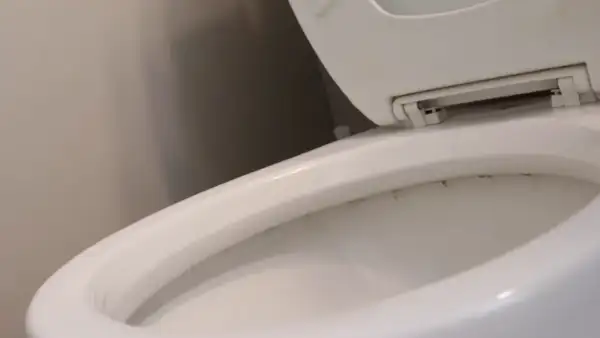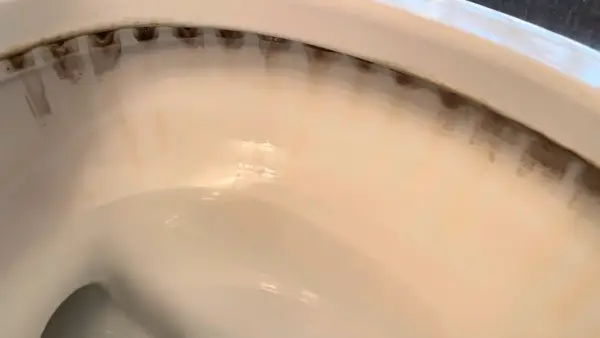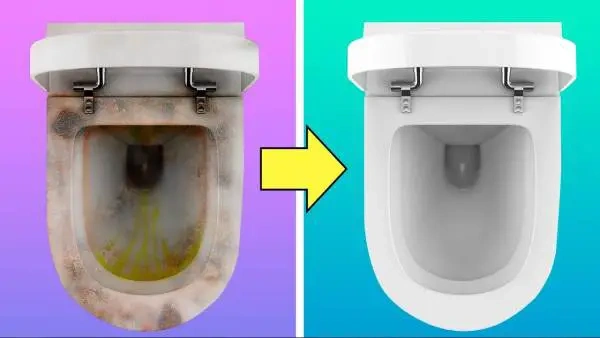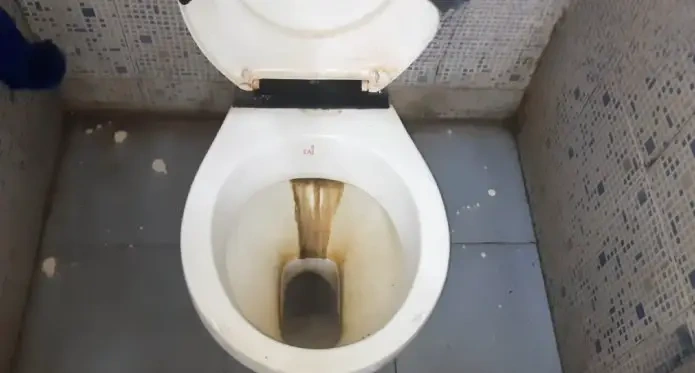Last Updated on October 17, 2023
Black spots in your toilet bowl can be quite an unsightly and perplexing issue. You’ve probably noticed them cropping up over time, and you might wonder, “Why does my toilet bowl turn black?”
Your toilet bowl may turn black for a variety of reasons. One common culprit is mold growth, which thrives in a dark, warm, and damp environment, often appearing above the waterline.
Another culprit is manganese deposits in the water supply, which can accumulate and manifest as dark stains lurking below the waterline.
But these are not only two possible causes for your toilet bowl turning black, as other reasons exist.
We’ll explore the diverse factors that can lead to those stubborn black stains and spots so you know what causes them and how to get rid of them.
Why Does My Toilet Bowl Turn Black: Potential Reasons

Several factors could be at play if you wonder why your toilet bowl turns black. In particular, these include:
- Mold growth
- Manganese deposits
- Hard water minerals
- Constant wet-dry conditions
- Breakdown of toilet components
- Rusty pipes
Let’s examine each of these reasons in detail so that you can understand why your toilet bowl has turned black.
Mold Growth
Mold can grow in a toilet bowl with residual water, resulting in a black appearance.
The damp, dark, and warm environment that the water creates provides an ideal breeding ground for mold spores to thrive. These spores are microscopic organisms that can be found virtually everywhere, including the air we breathe.
When they land on a wet surface like a toilet bowl, they begin to multiply and form colonies. As these colonies grow, they produce pigmented substances that give the mold its characteristic black color.
Manganese Deposits
The presence of manganese deposits in your toilet bowl can also cause black stains. Manganese is a naturally occurring element found in rocks and soil.
It can dissolve into groundwater and make its way into your water supply. When this happens, the manganese can react with other substances in the water and form dark-colored solids that settle on surfaces like your toilet bowl.
Hard Water Minerals

When you have hard water, minerals like iron and calcium can cause unsightly stains on your toilet bowl.
Water that contains high levels of dissolved minerals is called hard water. These minerals can come from natural sources such as rocks and soil or from man-made activities such as mining and industrial processes.
Iron in the water reacts with oxygen to form rust, which appears as a reddish-brown stain.
Calcium deposits are another common problem caused by hard water. When the water evaporates, it leaves behind white mineral deposits that can build up over time and become difficult to remove.
Constant Wet and Dry Conditions
If you frequently have wet and dry conditions in your toilet bowl, it creates an ideal breeding ground for dirt and other contaminants.
When the toilet bowl is constantly subjected to fluctuations in moisture levels, it provides a conducive environment for microorganisms to thrive.
These microorganisms can include bacteria, mold, and mildew, which contribute to forming black rings in the bowl. The dampness created by the wet and dry cycle allows these organisms to multiply rapidly, accumulating dirt and grime over time.
Breakdown of Toilet Components
The breakdown of internal toilet components can result in the release of black sediment into the bowl. These components, such as the float, flapper, or gaskets, may deteriorate or become worn out over time, causing them to malfunction.
For example, if the float fails to rise and shut-off the water supply when the tank is full, it can cause an overflow and allow water and sediment to enter the bowl.
Similarly, a faulty flapper or worn-out gasket can lead to leaks that introduce debris and sediment into the bowl.
Rusty Pipes
If you’ve been experiencing a black discoloration in your toilet bowl, one possible cause could be rusty pipes.
Corroded or rusted pipes can introduce rust particles into the water supply that flows into your toilet. Over time, these particles can accumulate and settle at the bottom of the bowl, causing it to turn black.
How to Remove Black Spots From a Toilet Bowl?

To remove black spots from your toilet bowl, you will need to follow a few simple steps. They’re:
Step 1: Prepare the Cleaning Solution
To clean black spots off a toilet bowl, you have to prepare and prepare the cleaning solution. But before that, you need to identify the type of black spots you’re dealing with.
You can make a paste for black mold spots by mixing borax or baking soda with vinegar.
On the other hand, black manganese spots can be removed by using a cleaning paste made of cream of tartar and 3% hydrogen peroxide.
Mix the ingredients to make the cleaning paste until you get a smooth consistency. You can adjust the amount of ingredients depending on the size of your toilet bowl.
Step 2: Apply the Cleaning Solution
After preparing your cleaning solution, it’s time to apply it to your toilet bowl. Use a toilet brush to swish the cleaning paste around the toilet bowl, making sure that it covers the black spots.
Be thorough and make sure every spot is coated with the paste. Then, let the paste sit for about 15 minutes before reapplying it. Repeat this process for an hour or two until the black spots start to fade.
Step 3: Scrub and Flush the Toilet Bowl
Once the cleaning paste has worked its magic, it’s time to scrub the toilet bowl. Use your toilet brush and scrub vigorously until the black spots have disappeared. You should exert some effort to get rid of stubborn stains.
After scrubbing, turn the water supply valve back on and flush the toilet. This will clear out any remaining residue and clean your toilet bowl.
Can you use bleach to remove black stains from your toilet bowl?
You can use bleach to get black stains out of your toilet bowl. But, you should exercise caution when using bleach, as it can be harsh and toxic.
Bleach is effective in removing stains, but it may not be the best choice for those who want a gentler and less toxic cleaning solution.
Also, if you have a septic system, using bleach can kill beneficial microbes, potentially affecting the system’s health.
Alternatives like baking soda and vinegar are considered milder options for stain removal and are less likely to harm your plumbing or septic system.
How often should you clean your toilet bowl to prevent black stains?
To prevent black stains, you should clean your toilet bowl regularly on a weekly basis.
Even if you don’t use the toilet frequently, it’s still necessary to clean it consistently to prevent the accumulation of minerals from hard water, which can lead to unsightly stains.
Taking Control Over Unpleasant Black Stains on Your Toilet Bowl
It is now clear the potential reasons behind those pesky black stains in your toilet bowl, from mold growth to manganese deposits and hard water minerals.
When you see these unwelcome marks, take the above-mentioned steps to tackle the issue effectively. Whether it’s preparing the right cleaning solution or scrubbing diligently, you have the tools to maintain a sparkling-clean toilet bowl.
Try to clean your toilet bowl every week to prevent the accumulation of these stains and ensure a hygienic and pleasant environment in your bathroom. Get rid of those unsightly black spots and enjoy a clean, fresh toilet bowl.

